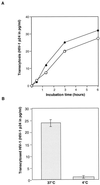Active and selective transcytosis of cell-free human immunodeficiency virus through a tight polarized monolayer of human endometrial cells
- PMID: 11333919
- PMCID: PMC114943
- DOI: 10.1128/JVI.75.11.5370-5374.2001
Active and selective transcytosis of cell-free human immunodeficiency virus through a tight polarized monolayer of human endometrial cells
Abstract
We report that both primary and laboratory-adapted infectious human immunodeficiency virus type 1 (HIV-1) isolates in a cell-free form are capable of transcytosis through a tight and polarized monolayer of human endometrial cells. Trancytosis of cell-free HIV occurs in a strain-selective fashion and appears to be dependent on interactions between HIV envelope glycoproteins and lectins on the apical membrane of the epithelial cells. These findings provide new insights into the initial events occurring during heterosexual transmission of the virus.
Figures




Similar articles
-
Neutralizing monoclonal antibodies to human immunodeficiency virus type 1 do not inhibit viral transcytosis through mucosal epithelial cells.Virology. 2008 Jan 20;370(2):246-54. doi: 10.1016/j.virol.2007.09.006. Epub 2007 Oct 24. Virology. 2008. PMID: 17920650
-
R5- and X4-HIV-1 use differentially the endometrial epithelial cells HEC-1A to ensure their own spread: implication for mechanisms of sexual transmission.Virology. 2007 Feb 5;358(1):55-68. doi: 10.1016/j.virol.2006.07.029. Epub 2006 Aug 24. Virology. 2007. PMID: 16934308
-
Cell-to-cell contact results in a selective translocation of maternal human immunodeficiency virus type 1 quasispecies across a trophoblastic barrier by both transcytosis and infection.J Virol. 2001 May;75(10):4780-91. doi: 10.1128/JVI.75.10.4780-4791.2001. J Virol. 2001. PMID: 11312350 Free PMC article.
-
Infectious human immunodeficiency virus can rapidly penetrate a tight human epithelial barrier by transcytosis in a process impaired by mucosal immunoglobulins.J Infect Dis. 1999 May;179 Suppl 3:S448-53. doi: 10.1086/314802. J Infect Dis. 1999. PMID: 10099117 Review.
-
HIV-1 infection in the female reproductive tract: role of interactions between HIV-1 and genital epithelial cells.Am J Reprod Immunol. 2011 Mar;65(3):253-60. doi: 10.1111/j.1600-0897.2010.00965.x. Epub 2011 Jan 12. Am J Reprod Immunol. 2011. PMID: 21223427 Review.
Cited by
-
HSV-2- and HIV-1- permissive cell lines co-infected by HSV-2 and HIV-1 co-replicate HSV-2 and HIV-1 without production of HSV-2/HIV-1 pseudotype particles.Virol J. 2007 Jan 5;4:2. doi: 10.1186/1743-422X-4-2. Virol J. 2007. PMID: 17207276 Free PMC article.
-
Mother-to-Child HIV-1 Transmission Events Are Differentially Impacted by Breast Milk and Its Components from HIV-1-Infected Women.PLoS One. 2015 Dec 17;10(12):e0145150. doi: 10.1371/journal.pone.0145150. eCollection 2015. PLoS One. 2015. PMID: 26680219 Free PMC article.
-
Origin of the transmitted virus in HIV infection: infected cells versus cell-free virus.J Infect Dis. 2014 Dec 15;210 Suppl 3(Suppl 3):S667-73. doi: 10.1093/infdis/jiu369. J Infect Dis. 2014. PMID: 25414422 Free PMC article. Review.
-
The importance of semen leukocytes in HIV-1 transmission and the development of prevention strategies.Hum Vaccin Immunother. 2020 Sep 1;16(9):2018-2032. doi: 10.1080/21645515.2020.1765622. Epub 2020 Jul 2. Hum Vaccin Immunother. 2020. PMID: 32614649 Free PMC article. Review.
-
Adaptive HIV-specific B cell-derived humoral immune defenses of the intestinal mucosa in children exposed to HIV via breast-feeding.PLoS One. 2013 May 21;8(5):e63408. doi: 10.1371/journal.pone.0063408. Print 2013. PLoS One. 2013. PMID: 23704905 Free PMC article.
References
-
- Agace W W, Amara A, Roberts A I, Pablos J L, Thelen S, Uguccioni M, Li X Y, Marsal J, Arenzana-Seisdedos F, Delaunay T, Ebert E C, Moser B, Parker C M. Constitutive expression of stromal derived factor-1 by mucosal epithelia and its role in HIV transmission and propagation. Curr Biol. 2000;10:325–328. - PubMed
-
- Bomsel M. Transcytosis of infectious human immunodeficiency virus across a tight human epithelial cell line barrier. Nat Med. 1997;3:42–47. - PubMed
-
- Chenine A L, Matouskova E, Sanchez G, Reischig J, Pavlikova L, LeContel C, Chermann J C, Hirsch I. Primary intestinal epithelial cells can be infected with laboratory-adapted strain HIV type 1 NDK but not with clinical primary isolates. AIDS Res Hum Retrovir. 1998;14:1235–1238. - PubMed
-
- Collins K B, Patterson B K, Naus G J, Landers D V, Gupta P. Development of an in vitro organ culture model to study transmission of HIV-1 in the female genital tract. Nat Med. 2000;6:475–479. - PubMed
-
- Cook D G, Fantini J, Spitalnik S L, Gonzalez S F. Binding of human immunodeficiency virus type I (HIV-1) gp120 to galactosylceramide (GalCer): relationship to the V3 loop. Virology. 1994;201:206–214. - PubMed
Publication types
MeSH terms
Substances
LinkOut - more resources
Full Text Sources
Medical

